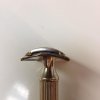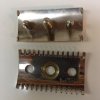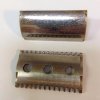Whoever could shed some light on what exactly my razor is, I'd appreciate it much.
I'm pretty sure it's an Old Type however, it's Canadian made, has pinched cap corners, scalloped base-plate and no numbers or markings anywhere. The handle it came on was rubbish so I put it on a fat Tech handle.
All other OT's I have researched don't have these markings (except for Made in Can), hence, I'm a bit puzzled. It does have the thicker cap and base-plate which means it is post 1921.
Anyone with some insight, please do..



I'm pretty sure it's an Old Type however, it's Canadian made, has pinched cap corners, scalloped base-plate and no numbers or markings anywhere. The handle it came on was rubbish so I put it on a fat Tech handle.
All other OT's I have researched don't have these markings (except for Made in Can), hence, I'm a bit puzzled. It does have the thicker cap and base-plate which means it is post 1921.
Anyone with some insight, please do..


